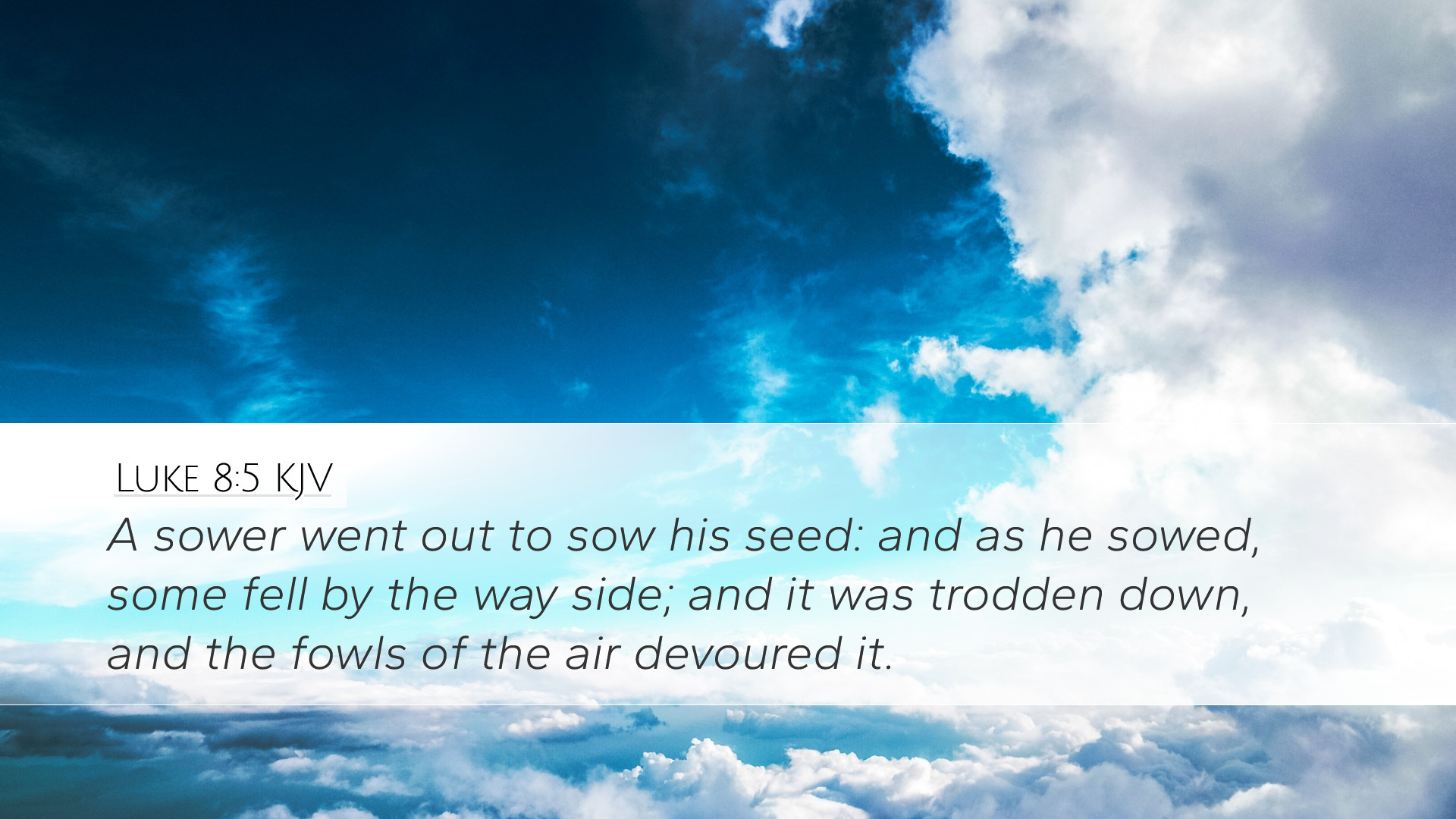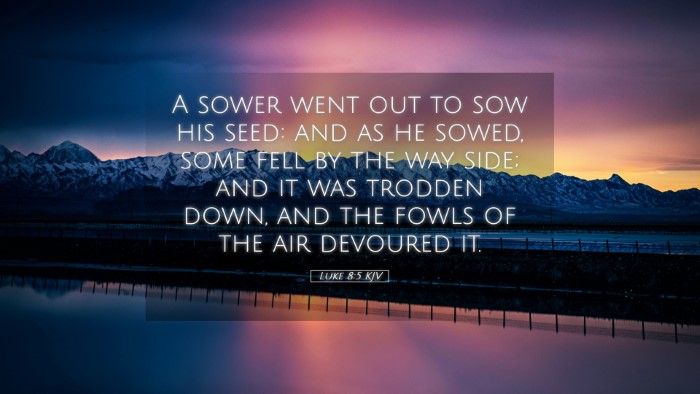Old Testament
Genesis Exodus Leviticus Numbers Deuteronomy Joshua Judges Ruth 1 Samuel 2 Samuel 1 Kings 2 Kings 1 Chronicles 2 Chronicles Ezra Nehemiah Esther Job Psalms Proverbs Ecclesiastes Song of Solomon Isaiah Jeremiah Lamentations Ezekiel Daniel Hosea Joel Amos Obadiah Jonah Micah Nahum Habakkuk Zephaniah Haggai Zechariah MalachiVerse
Luke 8:1 Luke 8:2 Luke 8:3 Luke 8:4 Luke 8:5 Luke 8:6 Luke 8:7 Luke 8:8 Luke 8:9 Luke 8:10 Luke 8:11 Luke 8:12 Luke 8:13 Luke 8:14 Luke 8:15 Luke 8:16 Luke 8:17 Luke 8:18 Luke 8:19 Luke 8:20 Luke 8:21 Luke 8:22 Luke 8:23 Luke 8:24 Luke 8:25 Luke 8:26 Luke 8:27 Luke 8:28 Luke 8:29 Luke 8:30 Luke 8:31 Luke 8:32 Luke 8:33 Luke 8:34 Luke 8:35 Luke 8:36 Luke 8:37 Luke 8:38 Luke 8:39 Luke 8:40 Luke 8:41 Luke 8:42 Luke 8:43 Luke 8:44 Luke 8:45 Luke 8:46 Luke 8:47 Luke 8:48 Luke 8:49 Luke 8:50 Luke 8:51 Luke 8:52 Luke 8:53 Luke 8:54 Luke 8:55 Luke 8:56


Commentary on Luke 8:5
Verse: "A sower went out to sow his seed: and as he sowed, some fell by the way side; and it was trodden down, and the fowls of the air devoured it."
Introduction
The parable of the sower is a foundational teaching of Jesus that illustrates the different responses to the Word of God. This commentary synthesizes insights from Matthew Henry, Albert Barnes, and Adam Clarke, focusing on the significance of the seed, the sower, and the various types of soil that represent the hearts of those who hear the Word.
Exegesis of the Text
The sower in this parable represents Christ Himself, who came to sow the seeds of the Gospel. The act of sowing is an intentional action, stressing the importance of evangelism and the dissemination of divine truth. The seed symbolizes the Word of God, which has transformative power and the ability to produce fruit.
The Sower
Matthew Henry notes that the sower represents Christ but can also be applied to all who disseminate the Gospel. This highlights the duty of every believer to share the message of salvation. The act of sowing requires perseverance and faithfulness, much like the early disciples who spread the Word despite opposition.
The Seed
Albert Barnes elaborates on the significance of the seed. He indicates that it is of great quality and potential. While the seed is the same, the varying results stem from the condition of the soil, which symbolizes the human heart. Each heart receives the Word differently, leading to different outcomes based on openness to God's message.
The Soil: Types of Response
The verse mentions various types of soil, and in doing so, Jesus gives us insight into human responses to God’s message. Each condition of the soil represents a different spiritual state.
Adam Clarke interprets the way side as those who do not take the Word seriously. They may hear it superficially, but it lacks any deep-rooted impact. The birds eating the seed represents wicked influences that snatch away the Word before it can take root.
Theological Implications
The parable conveys significant theological insights about the nature of the Kingdom of God. It serves as a reminder that God’s message is universal, but the reception is varied. Henry emphasizes that while the sower is diligent, the responsibility for growth lies with the recipients.
Grace and Free Will
This passage raises important questions about divine grace and human free will. Adam Clarke argues that while God is the initiator who brings the message to all, individuals must respond appropriately, indicating human agency in the spiritual journey.
The Role of the Church
The call to sow the seed challenges the church today. Every believer is a sower; thus, effective ministry requires a commitment to evangelism, discipleship, and nurturing those who respond to the Gospel. Barnes exhorts ministers to be mindful of their audience and the diverse responses they may encounter.
Application for Believers
The parable serves as both an encouragement and a warning. Believers are encouraged to share the Word boldly while understanding that not all will respond positively. Each individual should also examine their own heart to ascertain the condition of their spiritual life.
Conclusion
Luke 8:5 serves as a profound metaphor for spiritual receptivity and the power of God's message. The teachings from Matthew Henry, Albert Barnes, and Adam Clarke provide a robust understanding of the parable's implications for ministry, personal faith, and the nature of the Kingdom of God. As believers navigate their spiritual journeys, they are encouraged to reflect on their responses to God's Word, actively engaging in the mission of spreading the Gospel and producing fruit for the glory of God.